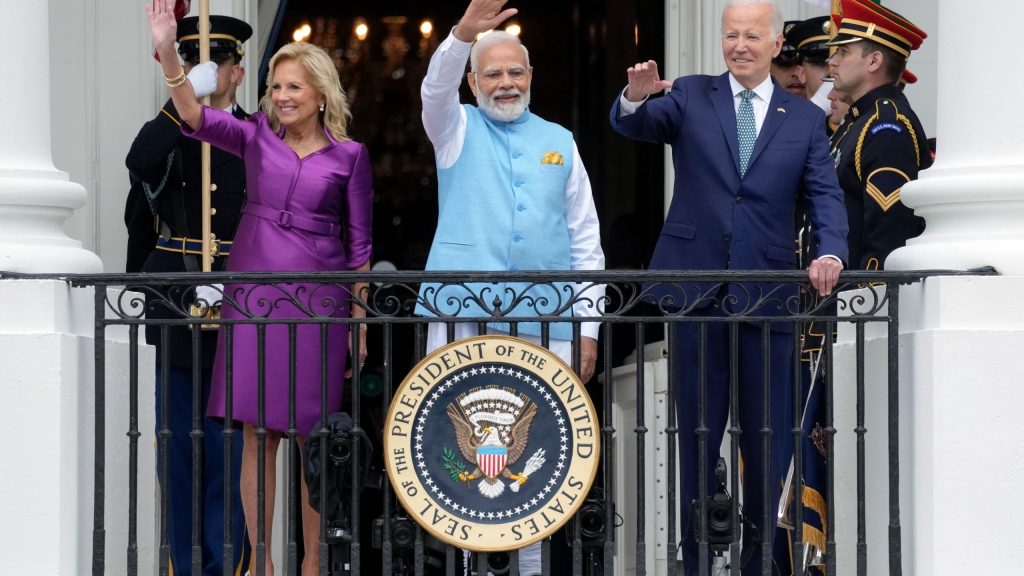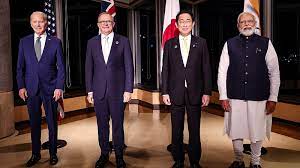
WASHINGTON/NEW DELHI: With China on the mind, the United States and India are set to intensify their engagement in the strategic geographies of the Indo-Pacific and South China Sea.
Issues relating to the Indo-Pacific, Quad and South China Sea featured prominently in discussions between Prime Minister Narendra Modi and US President Joe Biden in Washington DC on June 22. There was a meeting of minds on enhancing cooperation for shaping a free open, inclusive, peaceful, and prosperous India-Pacific region. In their talks and public statements, the two leaders stressed on respect for territorial integrity and sovereignty, and international law.
“Both leaders expressed concern over coercive actions and rising tensions, and strongly oppose destabilizing or unilateral actions that seek to change the status quo by force,” said the India-US joint statement in an oblique but obvious reference to China’s tactics of altering the status quo in South China Sea.
In a clear message to China, “both sides emphasized the importance of adherence to international law, particularly as reflected in the United Nations Convention on the Law of the Sea (UNCLOS).” The two sides also underlined their “commitment to the maintenance of freedom of navigation and overflight, in addressing challenges to the maritime rules-based order, including in the East and South China Seas.”
The India-US joint statement indicated clearly that the US will increase cooperation and engagement with India in the South China Sea. It is not clear yet what form this increased cooperation will take.

The emphasis on working together for freedom of navigation rules-based order came at a time when Vietnam has been at the receiving end of Chinese aggressive posture in South China Sea. On June 10, China’s patrol ship Hai Yang Di Zhi Jiu Hao and Xiang Yang Hong 10 sailed through Vietnam’s EEZ near oil and gas fields close to Vanguard Bank, sparking tensions in the region which has drawn international attention from New Delhi to Washington.
The rising tensions in the South China Sea, with China sending more ships to Vietnam’s Exclusive Economic Zone (EEZ), have underlined the need to resolve such issues with dialogue and diplomacy, rather than force.
Strengthening Quad

The discussion on South China Sea was a part of the larger India-US strategic convergence on shaping an inclusive Indo-Pacific and strengthening the Quad to deter Chinese aggression. In this regard, India and the US will intensify their cooperation in the Indo-Pacific across multiple domains.
In his welcome remarks at the White House, President Biden underscored that “the challenges and opportunities facing the world in this century require that India and the United States work and lead together.” “With your partnership, we’ve invigorated and elevated the Quad between the United States, India, Australia, and Japan to advance our vision of a free, open, secure, and prosperous Indo-Pacific,” he said while praising PM Modi for his role in strengthening the Quad.
“The developments in the Indo-Pacific area have always been an important area of cooperation between India and the US. That cooperation takes place across multiple domains,” said India’s Foreign Secretary Vinay Mohan Kwatra in response to a question from India Writes Network in Washington.
“In their discussion, PM Modi and President Biden focused on the nature of the challenges that the two countries face in the Indo-Pacific, including strategic challenges, and what India and US need to do across the different parts of their system to ensure that we mitigate those challenges through our cooperation,” said Mr Kwatra.
As part of their commitment to shape an inclusive Indo-Pacific, Prime Minister Modi and President Biden decided to intensify joint efforts to “empower the Quad as a partnership for global good.” In this context, the Indo-Pacific Partnership for Maritime Domain Awareness has made visible progress, allowing the four maritime democracies to provide maritime domain data across the Indian Ocean, Southeast Asia, and the Pacific regions.
India and the US will enhance their cooperation on Quad-related issues as New Delhi will host the Quad summit in 2024. Looking ahead, the two strategic partners will enhance their cooperation with regional platforms such as the Indian Ocean Rim Association, Indo-Pacific Oceans Initiative, and ASEAN to achieve shared aspirations and address shared challenges in the Indo-Pacific Region. “Prime Minister Modi welcomed the United States joining the Indo-Pacific Oceans Initiative and President Biden welcomed India’s continued participation as an observer in the Partners in the Blue Pacific,” said the joint statement.
With a view to checking China’s increasing forays in the Indian Ocean, the two governments will hold an inaugural Indian Ocean Dialogue in 2023. In days to come, one can also expect enhanced consultations between India and the US on regional issues including South Asia, the Indo-Pacific and East Asia.
The Road Ahead
Based on deepening India-US strategic convergence, one can expect New Delhi to shed its restraint and become more vocal on the South China Sea issue. In an indication of things to come, India has for the first-time asked China to abide by the 2016 arbitration award that had struck down China’s territorial claims in the South China Sea. The change in India’s position was mentioned in a joint statement issued by India and the Philippines after the fifth Joint Commission on bilateral cooperation in New Delhi on June 29. China had rejected the verdict of the international tribunal and refused to recognise the judgment.
Looking ahead, United States Assistant Secretary of State for East Asian and Pacific Affairs Daniel Kritenbrink has underlined that there would be greater collaboration among the Quad countries, including the US, India, Japan and Australia, on South China Sea. In this regard, the US diplomat said that the US will focus on building the capacity of allies, partners and friends that share a vision for a peaceful and stable world. “We will welcome cooperation with any country that embraces that vision. That of course includes India,” Kritenbrink said. “Large countries should not bully smaller ones,” he told Washington’s Center for Strategic and International Studies.
Seen in the larger strategic perspective, Prime Minister Narendra Modi’s historic January 20-23 visit to the US was a pointed message to China that the two largest democracies will work proactively to counter any attempts to subvert the rules-based order. The key outcomes of the Modi visit such as the forging of the next- generation defence and technology were conceived to bolster India’s capacity to act as a democratic counterweight to China.
Author Profile

- Manish Chand is Founder and Editor-in-Chief of India Writes Network (www.indiawrites.org) and India and World, a pioneering magazine focused on international affairs. He is CEO, Centre for Global India Insights, an India-based think tank focused on global affairs.
Latest entries
 In ConversationNovember 26, 2025G20 is a Force for global Good
In ConversationNovember 26, 2025G20 is a Force for global Good articlesNovember 26, 2025Rescuing G20 from North-South divide: Ubuntu Moment
articlesNovember 26, 2025Rescuing G20 from North-South divide: Ubuntu Moment India and the WorldOctober 27, 2025Modi hails the century of India and ASEAN, backs ASEAN centrality
India and the WorldOctober 27, 2025Modi hails the century of India and ASEAN, backs ASEAN centrality India and the WorldOctober 26, 2025Act East: Five reasons why ASEAN summit in Malaysia matters
India and the WorldOctober 26, 2025Act East: Five reasons why ASEAN summit in Malaysia matters







